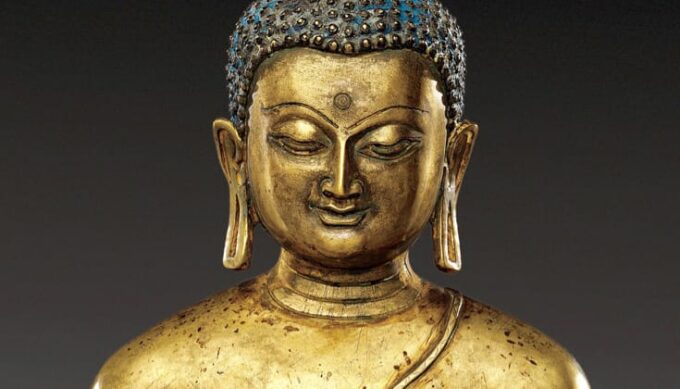ANATTĀ – THE NOT-SELF CHARACTERISTIC
Buddha said:
“Physical form, monks, is transient, and whatever is transient is unsatisfactory; whatever is unsatisfactory, that is anattā (non-self); and whatever is non-self, that is not of me, that I am not, that is not my self.”
Anattā can be translated as “non-self” or “substanceless” or ”insubstantiality”. Anattā is a composite Pali word consisting of an (not, without) and attā (soul).
The concept of anattā, or anātman, is a departure from the Hindu belief in atman (“the self”). The Buddhist concept of anattā or anātman is one of the fundamental differences between Buddhism and Hinduism, with the latter asserting that atman (self, soul) exists, whereas in Buddhism the doctrine posit that in humans there is no permanent, underlying substance that can be called the self. From the Buddhist point of view, the individual is compounded of five factors (Pali khandha; Sanskrit skandha) that are constantly changing.
Anattā is the word the Buddha used to describe what is commonly referred to as “self.” The Buddha describes the mental-physical ego-self as “anattā” to show the impermanent, ever-changing, insubstantiality of the conditioned ego-personality. What is thought of as self, as me or mine, is a deluded view rooted in ignorance (of the Four Noble Truths.)
Anattā, the not-self characteristic, is unique to the teachings of the Buddha – teaching that we find in the Anattalakkhana Sutta – and perhaps the most difficult to observe and understand. The more conditioned thinking is established, the more difficult it will be to grasp this truth, because we perceive ourselves through contact with our senses as the “perceiver” and all perceived phenomenon as outside of ourselves – therefore we must have a permanent and separate existence from other observed phenomena that appear “outside” of us, the “perceiver.” But what is perceived as a self is the ego-personality that has arisen from certain conditions (known as the Dependent Origination).
The ego-personality is the mental-physical form arisen from wrong views and maintained by clinging to wrong views. It is our ego-personality that is prone to endless confusion and suffering. Though insubstantial and ever-changing, our ego-self’s sole purpose is to continue to establish its “self” in every object, event, view, or idea. Anattā has created endless views of itself that are all subject to impermanence and suffering. It is in this underlying impermanence that the pervasive unsatisfactory experience of dukkha arises and is maintained.
Not-Self has also been misinterpreted and misapplied in some modern Buddhist schools to mean that the self is nothing, or a void, and has led some schools to create a doctrine of “nothingness” or “emptiness.” In the Buddhist text Samyutta Nikaya, Gautama Buddha was asked if there “was no soul (natthatta),” which it is conventionally considered to be equivalent to Nihilism (ucchedavada). Thus, the Buddha denied the existence of the mere empirical “self” but he distinguished his views from the nihilists (natthika) who denied the Soul. The Buddha said, “Both formerly and now, I’ve never been a nihilist (vinayika), never been one who teaches the annihilation of a being, rather taught only the source of suffering, and its ending”.
The Buddha did not teach that there is no self, only that the self fabricated through an observable process is not worth defending or continually re-establishing. The way to describe the Buddha’s teaching on Not-self is: anything that the ego-self clings to, whether objects, people, events, views, or ideas, or craving through the pursuit of happiness through acquisition of objects, people, events, views, or ideas, will create confusion, disenchantment, and lasting unhappiness. Not-Self simply means that what is commonly viewed as “self” is impermanent and insubstantial and requires a continual process of “I-making,” or conceit to continue.
One sense of the term anattā is that which has no independent existence and hence that which has no substantial nature of its own. This shows the close connection between anattā and the doctrine of Dependent Origination (paticcasamuppada). Since this latter doctrine maintains that nothing arises without depending on causes, it excludes the possibility of anything existing independently. Since the constituents that make up the human personality are described as dependently arisen (paticcasamuppanna pancakkhandha), it follows that within it there is no self-enduring substance or a self-entity existing by its own power.
All aspects of self are impermanent and any conditioned thought or thought construct that attempts to distract from this truth is also clinging, specifically clinging to views and ideas. Clinging to views and ideas maintains the distraction of stress and generates karma.
Anattā, not-self, continually seeks to establish itself in impermanent objects, views, and ideas. This is the purpose of the phenomenal world and why the ego-self is clinging to the world. As long as anattā continues this quest, confusion and suffering will prevail. As long as anattā continues this quest, karma will continue.
Every student of Buddhism knows that this concept is the most controversial of all the basic ideas of the system, and that many interpretations have been suggested by commentators, scholars, and critics. The main difficulty confronting the interpreters has been the lack of a clear definition of the term attā. The important fact that by the word attā books of the Pali Canon refer to a number of historical concepts that prevailed in India about the sixth century before Christ, and, therefore, the term must be defined accordingly in relation to the particular context under review. The adjective anattā is used as the universal characteristic of all dhammas, which is the third of the three signata or tilakkhaṇa.
Buddha himself is reported to have said, in describing one’s coming to enlightenment:
“A man is composed of six elements: solidity, fluidity, heat, motion, space, and consciousness. He analyzes them and finds that none of them are ‘mine’ or ‘me’ or ‘myself’. He understands how consciousness appears and disappears; how pleasant, unpleasant, and neutral sensations appear and disappear. Through this knowledge, his mind becomes detached.”
photo credit: whatbuddhasaid




